
When Camilla Parker Bowles married Charles, Prince of Wales, in 2005, she adopted the feminine form of one of her husband’s most significant titles, becoming Camilla, Duchess of Cornwall. Although Camilla is also the Princess of Wales, that title is so strongly connected to the late Diana Spencer that she mostly refrains from using it. As Duchess of Cornwall, she represents one of the most beautiful, historic and ceremonial counties in England.
_______________
“It has, therefore, been a favourite boast of the people of Wales and Cornwall,
that the original British stock flourishes in its unmixed
purity only among them.” —Thomas Bulfinch
_______________
Cornwall was one of the Celtic nations, a Brythonic kingdom and royal duchy. The Cornish people were a very religious and superstitious folk. The Cornish language, or Kernowek, was handed down from a language first used before the arrival of Anglo-Saxons. The fusion of Cornish with English over the centuries has created a unique Cornish dialect, filled with distinctive grammar and memorable sayings, such as “It is lucky to fall upstairs”, “tickling a child’s foot will make it stammer”, “to cure asthma, roll spider webs in a ball and swallow them” and the brilliant “a roaring cow do soon forget her calf”, which warns about the tendency to unreasonable argument that can cause harm to friends and family. Who isn’t familiar with that one?
Rick Stein’s Cornwall (2021) is a BBC television series that takes us on a culinary and cultural adventure tour around this marvellous and enigmatic county. Stein is a British celebrity chef but, uniquely, this series devotes only approximately 25 per cent of its fifteen episodes to cooking. There are, of course, some stunning dishes such as apple charlotte, Cornish mussels with cider (below), duck with a sea buckthorn sauce, Cornish bouillabasisse (made with gurnard and langoustines) and saffron buns, but most of the series focuses on the people, the art and the culture.
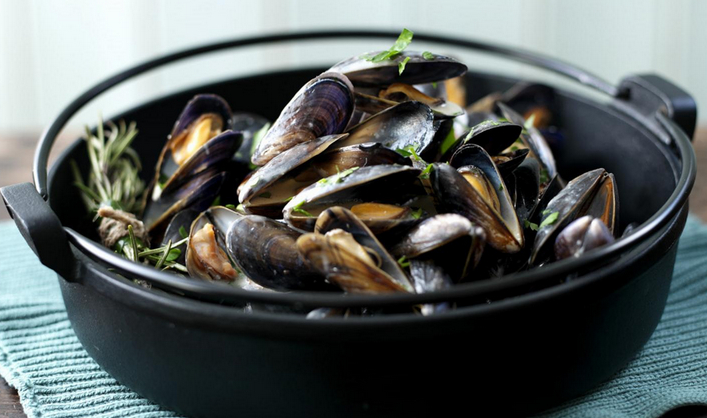
“Cornwall is different to anywhere else in the world and it’s that difference that I want to try to explain and tell you what Cornwall means to me.” So declares Rick Stein as he begins his journey at Poylenton, and the beautiful Art Deco building, with panoramic windows overlooking the sea, that his father and uncle built in the 1930s. He and his sister Henrietta shared a room and spent summer holidays there. He recalls his mother’s fishcakes and his father’s love for playing Schubert.
He travels to West Penwith, the most westerly part of Britain, to visit Kurt Jackson, who paints in the style known as plein air. He spreads his canvases on the ground where bits of shell and sand become mixed in with the pigments. Jackson originally painted in a local cave until fishermen built him a hut.
At Tresillian House, Stein talks with John Harris, who has created a “Noah’s Ark for Apples”. Harris’s life work has been a restoration of eighty-four old apple varieties, or a “living library”, including such apples as the Gilliflower, the Crimson Queen, the Lord of the Isles and the slightly oblong Pear Apple, which was used in the nineteenth century to make “soft cider for ladies”, contrasted with the rough version the local fishermen preferred.
Stein visits a family business that specialises in making Cornish Gouda cheese. The factory is situated in an old Nissen hut once used to house tanks during the war. An eight-year-old brine gives the cheese a distinctive flavor.
The fishing port of Mevagissey has been the centre of a huge pilchard, or Cornish sardine, industry since the seventeenth century. During the Napoleonic Wars, the port was a smuggling capital. Stein remembers, as a child, French crabbers coming into port and the next night brandy being available at the local pubs.
Cornwall’s climate is unique in Britain with warm, frost-free winters and early springs, ideal for 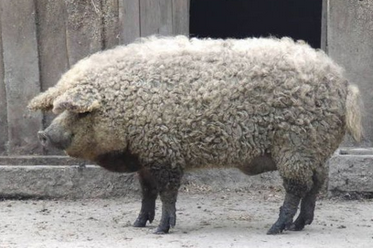 farmers, as crops can grow all year round. We meet Tom Adams, who was a successful chef in London who moved to Launceston to set up Coombeshead Farm Restaurant, with a dream of growing and rearing everything he serves. He maintains a herd of Mangalica pigs, an old Hungarian breed, that translates: hog with a lot of lard. Mangalica pigs live three times longer than other pigs and are known as the “Kobe beef of the pork world”. They are woolly creatures (right), much like sheep, and during the last century were bred specifically for the cosmetics industry in the manufacture of soaps and hand creams.
farmers, as crops can grow all year round. We meet Tom Adams, who was a successful chef in London who moved to Launceston to set up Coombeshead Farm Restaurant, with a dream of growing and rearing everything he serves. He maintains a herd of Mangalica pigs, an old Hungarian breed, that translates: hog with a lot of lard. Mangalica pigs live three times longer than other pigs and are known as the “Kobe beef of the pork world”. They are woolly creatures (right), much like sheep, and during the last century were bred specifically for the cosmetics industry in the manufacture of soaps and hand creams.
To celebrate the local seafood of his hometown, Padstow, Stein and his son Jack prepare a grand clambake on the beach. The ritual of digging the sand pit, filling it with burning charcoal, layering it with seaweed, then whole lobsters, another layer of seaweed, and finally a top layer of sand, and then slow-baking everything for three or four hours, reminded me of my own childhood in Painesville, Ohio, in the 1950s. My father would take me to celebratory clambakes on the beaches of Fairport Harbor, just across the Grand River from our house.
Stein grew up on the North Cornwall coast, next to the Camel estuary. He often references the poet John Betjeman, who wrote about the estuary, and another poet, Charles Causley, who recalls his mother, and a family picnic, in the evocative poem “Eden Rock”:
She pours tea from a Thermos, the milk straight
From an old H.P. sauce-bottle, a screw
Of paper for a cork; slowly sets out
The same three plates, the tin cups painted blue.
The dune bar on the Camel estuary is a favoured spot for crab fishing but is also deceptively shallow and very dangerous to manoeuvre. There have been 1100 known shipwrecks there.
Stein meets up with Barry Humphries (below), who relates his near-death experience off the coast near Zennor. In 1961, when he was developing his Edna Everage character, Humphries was on holiday and, while out walking, slipped on some ice and tumbled over the cliff, breaking his arm and dislocating his shoulder. He had to be airlifted out by helicopter. Footage of the rescue made the evening news.
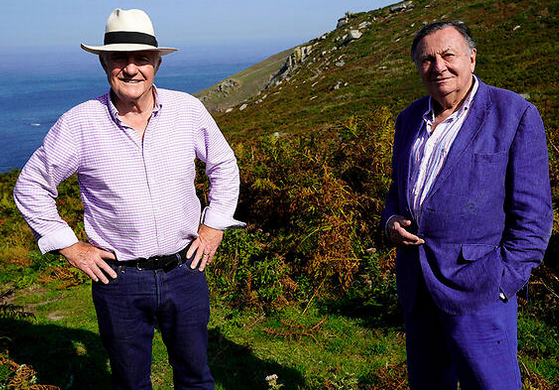
Stein and Humphries pay a visit to the grave of John Betjeman, at St Enodoc Church, in Trebetherick. Betjeman’s poem “Cornish Cliffs” summons the sense of place:
More than in gardened Surrey, nature spills
A wealth of heather, kidney-vetch and squills
Over these long-defended Cornish hills.
A gun-emplacement of the latest war
Looks older than the hill fort built before
Saxon or Norman headed for the shore.
Humphries, also a fine poet, whom Les Murray published in The New Oxford Book of Australian Verse, says Betjeman’s poems “do what poems should do. They have real emotion. They’re about things he knows about that connect with things that we know about … and they rhyme!”
Stein, who swims regularly, takes an early morning dip with the Perranporth Cold Water Swimmers, a group of women, with a local membership of 650 members, who are part of a national organisation known as the Bluetits. They wear blue beanies and a few even have dyed blue hair.
Back in Padstow, he visits master gardener Sir Tim Smith, creator of the Eden Project, massive botanic domes, in the “Lost Gardens of Heligen”. Heligen was bought by the Tremayne family in the sixteenth century and became a self-sufficient community, but nine of its thirteen gardeners were killed in the First World War. The gardens fell into disrepair but slowly over the years they have been restored (including the remarkable work below). In 2013, the gardens were registered as a living national memorial to these gardener-soldiers.
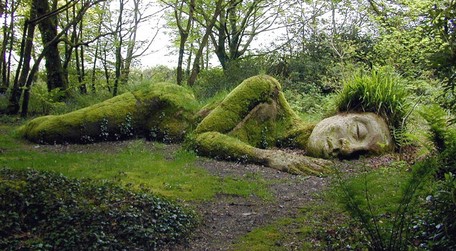
According to Laurence Dollimore of the Daily Mail, the Eden Project “has brought an estimated one billion pounds to the Cornwall economy”.
Stein then travels to Glitha Falls, in Liskeard, to spend time with the “Queen of Comedy”, Dawn French, who moved there sixteen years ago to start a new career as a writer. We stop by the St Austell china clay pit, whose special white clay is known as “Cornwall’s White Gold”—the main component of porcelain.
During the Second World War, some of Britain’s leading artists came to St Ives, including the sculptor Barbara Hepworth, who brought her four children. She died in 1975 in a fire at her home.
In Launceston, we visit Warnes butchers, established in 1880, who specialise in dry-aged meat. Dry-ageing removes water and intensifies the flavour as it passes through three cold rooms over twenty-one to thirty-five days where humidity is gradually lowered. In a surreal segment, Stein barbecues a dry-aged rib eye steak, with Béarnaise sauce, on a portable barbecue in the middle of a paddock, surrounded by a herd of curious cattle.
We go to Tintagel Castle, the birthplace of King Arthur, and on Roseland Peninsula explore how saffron is grown and harvested.
Stein next visits Chûn Quoit (old Cornish words for “house on the downs”), the best preserved of the Neolithic quoits. Quoits are closed chambers with mushroom-domed capstones, built around 2400 BC. Archaeologists have not be able to determine who built these structures or their purpose.
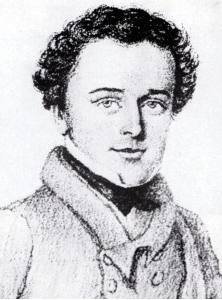 Finally, on the Morwenstow coast, Stein relates the story of Robert Hawker, a young Anglican clergyman and poet who arrived there in 1834. Hawker was the recipient of the 1827 Newdigate Prize for Poetry. In the local solitary stone church where Hawker preached, mounted on the wall is the original figurehead from the Caledonia, a 200-ton grain ship wrecked on the rocks below in 1842. As was the custom, bodies that washed up on the shores were just left there to rot, but Parson Hawker (left), as he was known to his congregation, directed that the corpses be carried to the church graveyard to receive Christian burials.
Finally, on the Morwenstow coast, Stein relates the story of Robert Hawker, a young Anglican clergyman and poet who arrived there in 1834. Hawker was the recipient of the 1827 Newdigate Prize for Poetry. In the local solitary stone church where Hawker preached, mounted on the wall is the original figurehead from the Caledonia, a 200-ton grain ship wrecked on the rocks below in 1842. As was the custom, bodies that washed up on the shores were just left there to rot, but Parson Hawker (left), as he was known to his congregation, directed that the corpses be carried to the church graveyard to receive Christian burials.
Many eccentric legends have been passed down about Hawker. Some include the priest dressing up as a mermaid and wearing a yellow horse blanket poncho that he declared was the habit of St Padarn. Hawker had nine cats, all which were allowed in his church—but he once “excommunicated” one for hunting mice on Sunday!
Rick Stein was born in 1947 in Oxfordshire to parents of German ancestry. He spent his childhood on a farm, which ill-prepared him for the school system, and he failed every course he took. In 1965 his father, who had bipolar disorder, committed suicide by throwing himself off a cliff. After a short stint as a chef in Paddington, Stein moved to Australia, working in an abattoir and a naval dockyard. He later returned to the UK and completed a degree in English. He opened a nightclub, known locally for its curries, but a series of brawls with local fishermen forced the police to close it down. In 1975, he married his first wife, Jill Newstead.
Joe Dolce’s reviews appear in every Quadrant.
Click here to subscribe
After they established a series of successful restaurants together, Newstead divorced him in 2007, after discovering Stein had been in a five-year affair with his publicist Sarah Burns, twenty years his junior. Stein and Newstead continued to run their restaurant businesses together. Four years later, he married Burns.
With his new wife, Stein opened a seafood restaurant in Mollymook, on the southern New South Wales coast in 2009, and nine years later, a second restaurant in Salamander Bay, Port Stephens.
He is known for his many excellent cooking shows (available on the Good Food cable network) and has travelled widely, creating an array of programs on the food and culture of Britain, France, India, Spain, the Far East, the Mediterranean and India, with books to accompany each series. Stein published a memoir in 2013, titled Under a Mackerel Sky. He, his shows and his books have won numerous awards. In 2003, he was awarded the OBE for services to tourism in Cornwall, and in 2018, a CBE for services to the British economy.
There is an ancient Cornish saying, “Gulls crying are the souls of men crying to be saved.” The folklore of Cornwall is replete with images of the sea, mermaids and pirates. It was a major smuggling area and was known for its “wreckers” who salvaged the ships that were destroyed on the rocky coastline. King Arthur is part of Cornish tradition, as is the medieval romance of Tristan and Yseult. Wagner’s opera of the same name is set in Cornwall. So is Gilbert and Sullivan’s Pirates of Penzance.
Giants form an important part of Cornish legends. The fairy tale “Jack the Giant Killer” (or “Jack and the Beanstalk”) is set there. There are also the lesser known legends of Cormoran and Cormelian, husband and wife giants from St Michael’s Mount; Blunderbore and Rebecks, cannibal giants, whom Jack also dispatched; Ralph the Wrath, who lived along the coast of Portreath and sank passing ships by throwing rocks at them; Bedruthen, the lazy giant, who lived along Newquay Bay; Bolster and Mrs Bolster, giants who ate the small children of St Agnes; and the “nice” giant of Carn Galver, who protected the humans that lived in Zennor and Movrah in exchange for goats and sheep to eat.
One of the centrepieces of Cornish mythology is the Legend of St Piran, a fifth-century Cornish abbot. According to the Cornwall Heritage Trust, St Piran (right) was known as “the merriest, hardest drinking, 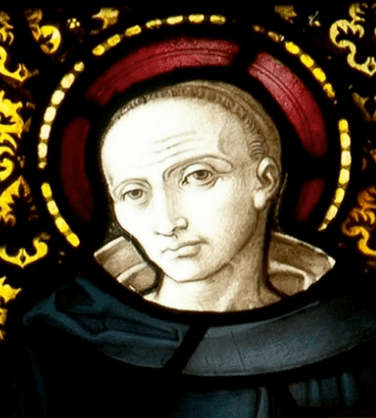 hardest living holy man Cornwall ever knew”. For various transgressions against King Aengus of Munster, Piran was sentenced to death by drowning, but survived, somehow floating to the Cornish coast at Perranporth. Piran founded a Celtic Christian church, St Piran’s Oratory, the oldest Christian church in Britain. It is said that he stumbled on a silvery liquid seeping out of a heated rock, leading to the development of the local tin industry. Piran became the patron saint of Cornish miners and is rumoured to have lived to be 206 years old. Saint Piran’s Flag, a white cross on a black background, is the national flag of Cornwall.
hardest living holy man Cornwall ever knew”. For various transgressions against King Aengus of Munster, Piran was sentenced to death by drowning, but survived, somehow floating to the Cornish coast at Perranporth. Piran founded a Celtic Christian church, St Piran’s Oratory, the oldest Christian church in Britain. It is said that he stumbled on a silvery liquid seeping out of a heated rock, leading to the development of the local tin industry. Piran became the patron saint of Cornish miners and is rumoured to have lived to be 206 years old. Saint Piran’s Flag, a white cross on a black background, is the national flag of Cornwall.
After the fall of the Roman empire, Cornwall and Devon became part of the Brythonic kingdom of Dumnonia. The Battle of Deorham (577 AD) resulted in the separation of Dumnonia from Wales and it became a dukedom of Wessex. The last recorded king of Cornwall, Dumgarth, was drowned in 838. It later became known as West Wales, to distinguish it from North Wales, the current nation of Wales.
In the nineteenth century an art colony was established in Newlyn including painters such as Stanhope and Elizabeth Forbes, Norman Garstin and Lamorna Birch. Between the wars, the painter Ben Nicholson and his wife, Barbara Hepworth, and writers such as D.H. Lawrence and Virginia Woolf resided there.
Daphne du Maurier lived near Fowey in Cornwall. Her famous short story “The Birds”, filmed by Alfred Hitchcock, had a Cornish setting, as did her novels Jamaica Inn, Rebecca and Frenchman’s Creek. Arthur Conan Doyle’s Sherlock Holmes story “The Adventure of the Devil’s Foot” was set in Cornwall. The county features prominently in the poetry of John Betjeman.
From 1840 onwards, during the “Hungry Forties”, food shortages caused by the potato blight led to emigration from Cornwall. Port Adelaide became a preferred destination. The discovery of copper mines in South Australia led to advertisements of work available for men who had trade skills and a “good character”, stressing that no convicts had been transported to South Australia. A high percentage of migrants to the state came from Cornwall, and the Yorke Peninsula became known as “Little Cornwall”.
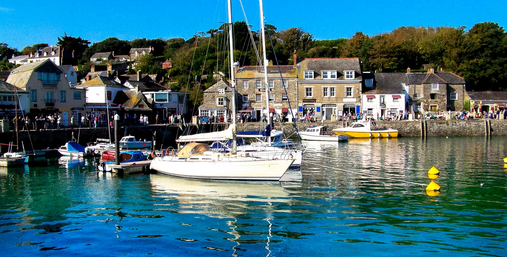
Rick Stein’s Cornwall has significantly increased tourist trade to Cornwall and particularly to his hometown of Padstow (above), not only due to his programs and cookbooks, but also his famous local seafood restaurant and a myriad of satellite businesses in the area, including a cooking school, café, fish-and-chip shop, bar and bistro. He also runs restaurants in the southern English localities of Barnes, Sandbanks and Winchester.
Travel Gourmet Magazine highly recommends this series:
[Stein] packs a huge amount into each half-hour episode. Of course there is an emphasis on food but there’s a lot more … he always throws some history and literature—often poetry—into the narrative. [He] did an English degree at Oxford University—[his] love of literature and poetry is real.
Stein’s influence has created so much work in Padstow that it is sometimes referred to as “Padstein”. But not everyone is happy with his presence there. A local fisherman, Gary Eastwell, told Steven Morris of the Guardian, “He doesn’t buy any fish from us. We get beautiful lobster, pollock, line-caught bass, monkfish … He could walk over here and buy it but he doesn’t. He gets it from a fish merchant instead.” Several residents of Porthleven, where Stein opened a restaurant in 2014, have commented that they couldn’t imagine eating there as it caters for “posh” people. Despite Porthleven having a lucrative summer tourist trade and homes worth half a million pounds on the harbour, the town mayor Andrew Wallis posted on his blog that “a tenth of homes do not have central heating, while 16% of children and 17% of pensioners live in poverty”.
There is a second season of Rick Stein’s Cornwall (2022). As well as preparing another dozen or so enticing local recipes, Stein tells about the raids by Barbary pirates that enslaved thousands of people from Britain’s coastal communities, the old Cornish folk tale of the Mermaid of Zennor, and he introduces us to Cornish chef Emily Scott who prepares a local turbot dish she made for US President Biden at the 2021 G7 summit. Stein travels to St Ives to celebrate the Cornish artist and fisherman Alfred Wallis and the painters Stanhope Forbes and Walter Langley. He talks about Dylan Thomas’s time in Mousehole, novelist Thomas Hardy’s time in Cornwall and takes us to the home of the Nobel Prize winner William Golding, author of Lord of the Flies
 Sign In
Sign In 0 Items (
0 Items ( Search
Search







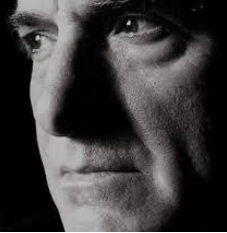


Having driven over much of the UK and spent plenty of time in Cornwall, I would not say, as an outsider, that Cornwall looked dramatically different to other places in that part of England. Lovely certainly, but unique, no.
Stein is good when he is talking about food and cringe-making when he is being a Woke Bloke.
Cornwall has donated much to delight.
For keen gardeners, J.C. Williams of Caerhays Castle made one if the first crosses between camellia species, japonica X saluenenis. This improved the range of climates where camellias could be grown, as well as their beauty. Geoff S
https://visit.caerhays.co.uk/the-estate/the-gardens/history-of-the-x-williamsii-camellia/
My wife likes some cooking programs, I definitely do not. But I like all the background that Rick Stein provides. I also like Chalky.
I had several holidays in Cornwall in the nineties and had a Cornish grandmother. Steeped in history, I loved the place, memories I will never forget, particularly the stairs at Tintagel up which I had to carry my then young son! Mystical, like much of the UK. Beautiful.